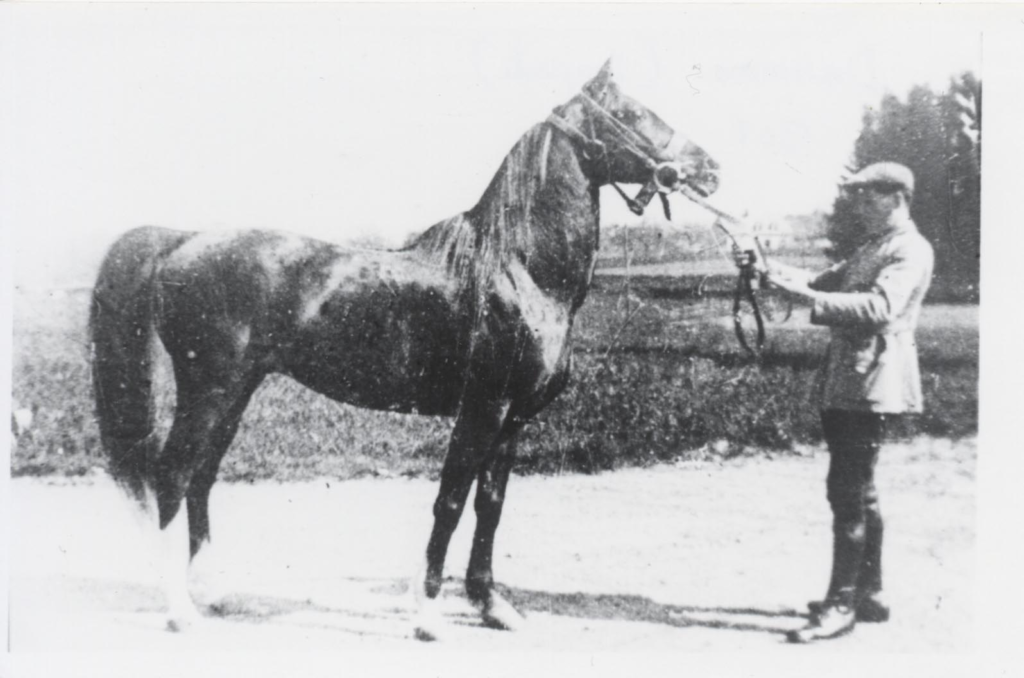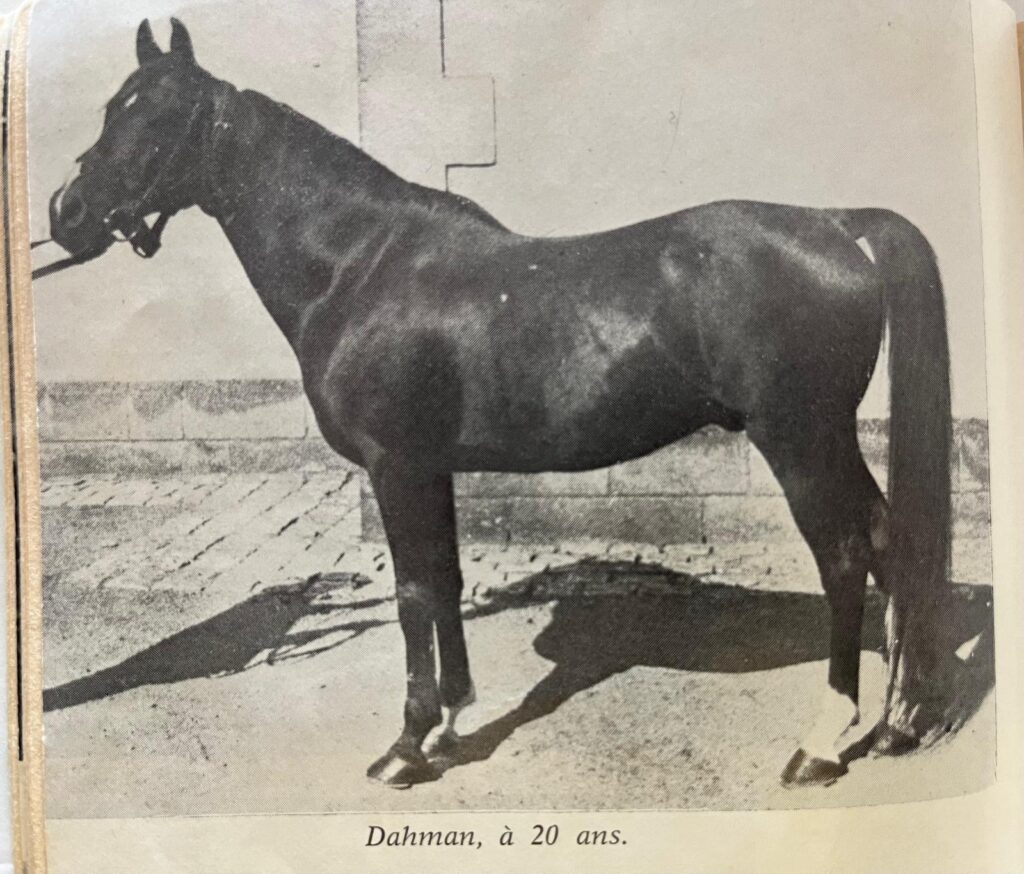Hujjah of French desert-bred stallion Dahman and possible link to Rabdan El Azrak (APK)

The stallion Dahman (b. 1900) was one of the most admired horses ever imported by the French government from the Middle East. Robert Mauvy, who knew him well, wrote beautiful pages about Dahman and his influence on both the Arabian and Anglo-Arabian breed in his book Le Cheval Arabe. Mauvy held Dahman as the archetype of the classic Arabian horse and provided a French translation of hujjah:
“L’un des plus représentatifs de la race et des plus impressionnants était sans contredit l’étalon Dahman, alezan brûlé, 1, 45 m, aussi brillant dans l’attitude que dans l’action (né en Orient en 1900 dans la tribu des Chammars, importé en 1909), donc voici la traduction de la hudje:
“Louange a Dieu, clément et miséricordieux, qui nous a créé des bienfaits et entre autres celui des chevaux, puisque la félicité est au-dessus des sabots des chevaux, tel qu’il l’a dit anciennement.
Louange a Dieu qui nous a dotés de cela et que nous avons négligé d’en réjouir.
Arbre généalogique du cheval alezan foncé ayant trois balzanes aux pieds, exception faite du pied gauche du devant, avec une pelote descendant jusqu’aux naseaux. Il est agé de cinq ans, il s’appelle Dahman, son père est Dahman, sa mère est Rabda. Il a été élevé par Ben Bassam et il est destiné a perpétuer sa race.
Dont certificat le 14 Moharrem 1327:
Cheikh Mohamed Hassanin, Checikh Mohamed Mohamed, Hamid Yaour Soliman, Abou Helal, Mohamed el Kattan, Mohamed Mansour et trois empreintes illigibles.

The Arabic version of the hujjah is not available, so we are left with the French version above. It still is very instructive, when paired with background information. Mauvy indicated that French government inspector Quinchez had obtained Dahman in 1909, from an army or a police barrack in Alexandria, Egypt, where he was being used at stud. He also reported that Quinchez had seen Dahman’s offspring in the vicinity. He added that the French mission’s vet, having examined the horse’s teeth, had concluded that he was nine years old, so over the five-year age limit for French government purchases. According to Mauvy, Quinchez had retorted: “Well, you will make him four year younger!”
Now back to the hujjah. The date of Moharram 1327 Hijri corresponds to January 1909 in the Gregorian calendar. This indicates that the hujjah was prepared in Egypt upon the horse’s purchase, and that one should be looking in the direction of Egypt when trying to identify the signatories. This clue had eluded me for many years, as I had previously been looking for familiar Shammar tribesmen’s names among the hujjah‘s witnesses, and not finding any. Once one looks to Egypt, as opposed to the Shammar tribe in Arabia, the list of witnesses starts talking:
First, Ibn (Ben) Bassam, the horse’s “breeder”. His first name is not mentioned. He must have been famous enough in these circles to be referred to by his last name only (e.g., Ibn Saud). It is clear, however, that Ben Bassam is a reference to the ‘aqayl Ibn Bassam of Buraydah in the Qasim area of Central Arabia. ‘Ali ‘Abdallah Ibn Bassam was a familiar figure in the Arabian horse breeding circles of Egypt around that time, procuring horses from Central Arabia for such people as Prince Ahmad Pasha Kamal and the Blunts. He arranged Lady Anne Blunt’s last importation from Arabia in 1911-13 (Saadun, Krushan, Dohayya, Saade, Aida, and Jauza). He, or his father, also brought Rabda (APK) , the dam of Rabdan El Azrak for Prince Ahmad Pasha Kamal.
Says Lady Anne Blunt, in a 1909 entry in her Sheykh Obeyd Catalogue: “the original mare Kehileh Rabdieh [sic] brought from Arabia by Ibn Bassam…”. Note how she too used Ibn Bassam’s patronym only. Now — surprise! — the French Dahman’s strain of Rabdan is also the strain of Rabda (APK), further cementing the connection with Ibn Bassam. Dahman’s dam was from the Shammar, per Mauvy, and Raswan wrote that Radba (APK) also was from the Shammar, without giving his source (he rarely did). Dahman took his name from his sire, a Dahman.
It then becomes tempting to imagine Dahman (France), who was born ca. 1900 and sired by a Dahman out of a Rabda of Ibn Bassam from the Shammar (per his hujjah and Mauvy), as a full brother of Rabdan El Azrak (APK), who was born around three years earlier in 1897 and was sired by a Dahman (El Azrak) out of a Rabda of Ibn Bassam (per Lady Anne Blunt Journals and catalogs, the 1932 pedigree of *Nasr, and the RAS History). I don’t have direct evidence of this, so it’s all speculation, but everything does match: the Rabdan strain, the Shammar tribal original, Ibn Bassam as a “naisseur”/owner at birth. Add to that the shortlived association of Rabda (APK) with Ahmad Pasha Kamal, with Rabdan El Azrak as her only offspring recorded there. Should a sire line to Dahman (France) still exist among Anglo-Arabians, it is worth comparing its Y-DNA with that of Rabdan El Azrak’s.
The second relevant name is that of Abou Helal. This was another horse merchant, this one specializing in horses from Syria. Abou Helal appears in many old hujaj of Tahawi horses imported from Syria and Northern Arabia to Egypt, like this one: the bay ‘Ubayyah which came from Salih al-Misrab at the hand of Husayn Abu Hilal in 1356 H.”
The other signatories’ names are too generic for me to identify, but I think that the names Ibn Bassam and Abou Helal in this hujjah firmly place the French imported Dahman among the more authenticated horses that came out of the Middle East to France.

Oh, definitely worth testing the tail male, if it still exists, and comparing with Rabdan El Azrak.
Comparing the photos of Dahman with Rabdan El Azrak, and thinking that the head shape might be similar; both horses are high in the haunches as well. Dahman being alezan brûlé/foncé makes me think of Ibn Rabdan, who was a dark chestnut too. Of course, drawing conclusions from a handful of old photographs is not the wisest thing to do!
A sireline to Dahman (France) may be surviving in Arab-Barb horses, particularly in Morocco.
Hes got some triangles!
best
Bruce Peek
Honestly, I think it is so exciting that we’re at a point where the sirelines / y-chromosome haplotypes can be studied accurately enough to make these kinds of connections. I hope a stallion or two turns up!
This is an amazing piece of research, Edouard. As you say, now we test it. Old photos can lie: that said, this reminds me of Ibn Rabdan in balance and carriage.
Really interesting! Let’s get that y-chromosome haplotype checked!
I added another photo of Dahman from Mauvy’s book